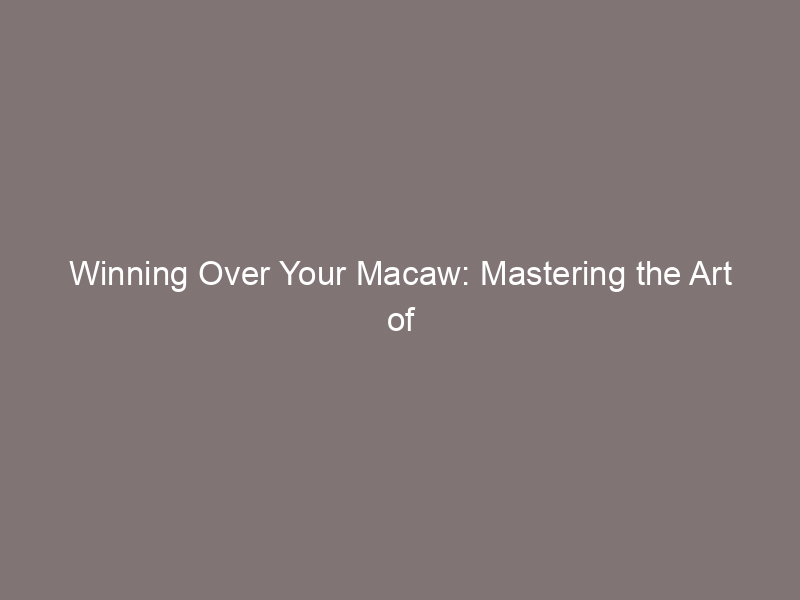
Introduction to Macaw Bonding Techniques
Macaws are magnificent creatures, known for their vibrant colors, intelligence, and sociability. However, building a strong bond with these birds requires understanding and patience. This article aims to guide you through the process of bonding with your Macaw, highlighting the importance of this relationship and the challenges you might face.
- Understanding the Importance of Bonding with Your Macaw
- Challenges in Building Trust with Macaws
Bonding with your Macaw is not just about creating a friendly relationship; it’s about building trust and mutual respect. When a Macaw trusts its owner, it becomes more comfortable, happier, and healthier. It also leads to better cooperation during training sessions, making it easier for you to teach your bird new tricks and commands. A well-bonded Macaw is also less likely to display aggressive or destructive behaviors, making your life as a pet owner much more enjoyable.
While bonding with a Macaw can be a rewarding experience, it’s not without its challenges. Macaws are intelligent and sensitive birds, and they can be wary of new people and environments. Building trust with a Macaw takes time and patience. It’s important to approach your bird in a calm and respectful manner, avoiding sudden movements or loud noises that might scare it. It’s also crucial to spend quality time with your bird every day, engaging in activities that it enjoys. This could be anything from playing with toys to simply sitting and talking to your bird.
In the following sections, we will delve deeper into the steps you can take to build trust with your Macaw, including practical tips and advice based on expert knowledge and real-life experiences. Stay tuned to learn more about the art of bonding with these beautiful birds.
Building Trust with Macaws: The Initial Steps
Building trust with your Macaw is an essential part of your relationship. This process is not something that happens overnight, but rather, it requires patience, understanding, and respect. Here are some initial steps you can take to start building that trust.
- Creating a safe and comfortable environment for your Macaw
- Understanding your Macaw’s body language
- Respecting your Macaw’s personal space
First and foremost, your Macaw needs to feel safe and comfortable in its environment. This means providing a clean, spacious cage with plenty of toys and activities to keep it occupied. The cage should be placed in a quiet, low-traffic area of your home where your Macaw can relax and feel secure. Remember, a happy Macaw is more likely to trust its owner.
Macaws, like all birds, communicate primarily through body language. By paying close attention to your Macaw’s behavior, you can learn to understand what it’s trying to tell you. For example, a Macaw that’s fluffing its feathers and bobbing its head is likely excited and happy, while a Macaw that’s crouching with its feathers slicked down is likely scared or upset. Understanding these signals can help you respond appropriately and build trust with your Macaw.
Just like humans, Macaws need their personal space. Always approach your Macaw slowly and calmly, and never force interaction. If your Macaw seems uncomfortable or tries to move away, respect its wishes and give it some space. This respect for your Macaw’s personal space will show it that you can be trusted.
In conclusion, building trust with your Macaw requires patience, understanding, and respect. By creating a safe and comfortable environment, understanding your Macaw’s body language, and respecting its personal space, you can start to build a strong, trusting relationship with your feathered friend.
Macaw Trust Building: The Art of Patience
Building trust with your Macaw is a journey that requires a lot of patience. This section will explore why patience is key, how to show patience, and a case study demonstrating the impact of patience on Macaw trust building.
- Why patience is key in building a trusting relationship with your Macaw
- How to show patience when interacting with your Macaw
- Case Study: The impact of patience on Macaw trust building
Patience is the cornerstone of any successful relationship, and it’s no different with Macaws. These intelligent birds need time to adjust to new environments and people. Rushing the process can lead to stress and fear, which can damage the bond you’re trying to build. Patience allows your Macaw to get comfortable at their own pace, fostering a sense of security and trust.
Showing patience with your Macaw involves understanding their behavior and responding calmly. Avoid forcing interaction. Instead, allow your Macaw to approach you when they feel comfortable. Use a calm and gentle voice when speaking to them, and avoid sudden movements that might startle them. Remember, building trust is not a race, but a marathon.
Consider the case of Charlie, a Blue and Gold Macaw. His owner, Sarah, adopted him from a rescue center. Initially, Charlie was wary of Sarah, often retreating to the farthest corner of his cage when she approached. However, Sarah was patient. She spent time near Charlie’s cage, talking softly to him and offering treats. After several weeks, Charlie began to respond positively, accepting treats from Sarah’s hand and even stepping onto her arm. This case study highlights the power of patience in building trust with a Macaw.
| Key Takeaways |
|---|
| Patience is crucial in building a trusting relationship with your Macaw. |
| Show patience by understanding your Macaw’s behavior and responding calmly. |
| Case studies, like Charlie and Sarah’s story, demonstrate the positive impact of patience on Macaw trust building. |
In conclusion, patience is not just a virtue, but a necessity when it comes to building trust with your Macaw. By understanding their behavior and responding with patience and calm, you can foster a strong, trusting bond with these beautiful birds.
The Art of Bonding with Birds: Macaw Care Tips
One of the most important aspects of bonding with your pet bird is understanding and catering to their needs. This includes feeding and diet, which plays a crucial role in their health and happiness. Here, we will discuss the dietary needs of Macaws and how feeding can help in bonding with your pet bird.
Feeding Your Macaw
Feeding your Macaw is not just about providing food, it’s about understanding their dietary needs and using this time to bond with them. Let’s delve deeper into these aspects.
- Understanding your Macaw’s dietary needs
- How feeding can help in bonding with your pet bird
Macaws, like all birds, have specific dietary needs. They require a balanced diet that includes fruits, vegetables, nuts, and seeds. In the wild, Macaws eat a variety of foods to get the nutrients they need. In captivity, it’s your responsibility to provide a similar variety. A diet solely based on seeds or pellets is not enough. Fresh fruits and vegetables should make up a significant portion of their diet. Remember, each bird is unique and may have specific dietary preferences and needs. Always consult with a vet for personalized advice.
Feeding time is a great opportunity to bond with your Macaw. Hand-feeding your bird can help build trust and strengthen your relationship. It’s a time when you can interact closely with your bird, observe their behaviors, and respond to their needs. It’s also a time when your bird is likely to be more receptive to you, as they associate you with food and nourishment. Remember, patience is key. It may take time for your bird to feel comfortable eating from your hand, but with consistency and care, they will learn to trust you.
In conclusion, understanding your Macaw’s dietary needs and using feeding time as a bonding opportunity can significantly enhance your relationship with your pet bird. Remember, a healthy bird is a happy bird, and a happy bird is more likely to bond with you.
Grooming Your Macaw
Grooming is an essential part of caring for your Macaw. Not only does it keep your bird looking its best, but it also plays a significant role in their overall health and well-being. Furthermore, grooming can also serve as a bonding activity between you and your Macaw.
- Importance of grooming in Macaw care
- How grooming can strengthen your bond with your Macaw
Grooming is not just about maintaining your Macaw’s appearance. It’s also about ensuring their health. Regular grooming helps prevent skin diseases and feather disorders. It also allows you to check for any abnormalities like lumps, cuts, or signs of illness that may otherwise go unnoticed.
Proper grooming includes regular baths, nail trimming, and feather care. Macaws, like other birds, need baths to keep their feathers clean and healthy. Nail trimming is necessary to prevent overgrowth, which can lead to discomfort and mobility issues. Feather care involves regular checks for any damaged or broken feathers that need to be removed.
Grooming is a great opportunity to strengthen your bond with your Macaw. It’s a time when you can interact closely with your bird, building trust and understanding. As you groom your Macaw, you’re showing them that you’re a source of comfort and care.
During grooming, speak softly and gently to your Macaw. This will help them associate grooming with positive experiences. Over time, your Macaw will start to look forward to grooming sessions as a time of bonding and interaction with you.
In conclusion, grooming is an essential part of Macaw care. It’s not just about keeping your bird looking good, but also about ensuring their health and strengthening your bond with them. So, make sure to include regular grooming in your Macaw’s care routine.
Building a Relationship with Your Macaw: Training Tips
Building a strong and trusting relationship with your Macaw is an essential part of pet ownership. Training plays a significant role in this process. Let’s delve into the importance of training, effective techniques, and the role of positive reinforcement in Macaw training.
- Importance of Training in a Trusting Relationship with Macaw
Training your Macaw is not just about teaching them tricks or commands. It’s about building a bond of trust and understanding. When you train your Macaw, you spend quality time with them, learn their unique behaviors, and communicate with them effectively. This interaction helps to foster a strong bond between you and your pet.
- Effective Macaw Training Techniques
Effective training techniques are crucial for building a relationship with your Macaw. Here are some tips:
- Start with simple commands: Begin with easy commands like ‘step up’ or ‘step down’. This helps your Macaw to understand and respond to your instructions.
- Use a calm and patient approach: Macaws can be sensitive. Always use a calm and patient approach during training sessions. This will help your Macaw to feel safe and comfortable.
- Consistency is key: Consistency in training sessions is essential. It helps your Macaw to understand what you expect from them and reinforces their learning.
- Key Takeaway: The Role of Positive Reinforcement in Macaw Training
Positive reinforcement is a powerful tool in Macaw training. It involves rewarding your Macaw for their good behavior or correct response to a command. This could be a favorite treat, praise, or a gentle pat. Positive reinforcement encourages your Macaw to repeat the behavior, helping them to learn and understand commands more effectively.
In conclusion, training is a vital part of building a trusting relationship with your Macaw. It involves time, patience, and understanding. But with the right techniques and positive reinforcement, you can build a strong bond with your Macaw and enjoy a rewarding pet-owner relationship.
| Training Technique | Description |
|---|---|
| Simple Commands | Begin with easy commands like ‘step up’ or ‘step down’ |
| Calm and Patient Approach | Always use a calm and patient approach during training sessions |
| Consistency | Consistency in training sessions is essential |
| Positive Reinforcement | Reward your Macaw for their good behavior or correct response to a command |
Understanding Macaw Behavior: A Key to Bonding
Understanding your Macaw’s behavior is a crucial step in building a strong and lasting bond. Macaws, like all birds, have unique ways of expressing their feelings and needs. By learning to interpret these signals, you can improve your relationship with your pet and provide them with the care they need.
- Common Macaw behaviors and what they mean
Macaws exhibit a range of behaviors that can tell you a lot about their mood and well-being. Here are a few common ones:
| Behavior | Meaning |
|---|---|
| Squawking | Macaws are known for their loud voices. Squawking is a way for them to communicate with their flock, express excitement, or signal that they are upset or scared. |
| Preening | When a Macaw preens, it’s usually a sign that they are comfortable and content. They often preen their feathers to keep them in good condition. |
| Biting | Macaws may bite when they are scared or feel threatened. It’s essential to approach them calmly and gently to avoid this behavior. |
- How understanding your Macaw’s behavior can help in bonding
Understanding your Macaw’s behavior can significantly improve your bond. By recognizing their signals, you can respond appropriately to their needs, which builds trust and respect. For instance, if your Macaw is squawking loudly, it might be a sign that they are scared or upset. Instead of scolding them, try to find out what’s causing their distress and address it.
Similarly, if your Macaw is preening, it’s a sign that they are relaxed and comfortable. You can use this time to gently interact with them, reinforcing the bond between you.
Remember, patience is key when it comes to bonding with your Macaw. It may take time for them to trust you fully, but by understanding their behavior and responding with care and respect, you can build a strong and lasting relationship.
Conclusion: The Joy of Bonding with Your Pet Bird
As we come to the end of our journey, it’s important to reflect on what we’ve learned about the beautiful process of bonding with your Macaw. It’s a journey filled with patience, understanding, and ultimately, an unbreakable bond of trust and companionship.
- Recap of Macaw bonding techniques and trust-building strategies:
- The lifelong benefits of a trusting relationship with your Macaw:
We started by understanding the importance of patience in the bonding process. We learned that trust is not built overnight, and it requires consistent and positive interactions. We also discovered various techniques such as gentle handling, talking softly, and providing treats, which can help in building a strong bond with your Macaw.
Building a trusting relationship with your Macaw is not just about making your pet feel comfortable. It’s about creating a bond that will bring joy, companionship, and a unique understanding between you and your feathered friend. A bonded Macaw can be a source of endless entertainment, affection, and even emotional support. The benefits of this relationship are indeed lifelong and deeply rewarding.
Remember, every Macaw is unique and will bond at their own pace. The key is to be patient, consistent, and understanding. The joy of bonding with your pet bird is an experience like no other, and it’s worth every moment of patience and effort you put into it. So, here’s to a lifetime of joy, companionship, and colorful conversations with your Macaw!






